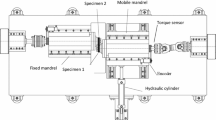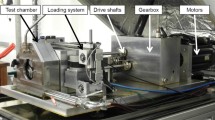Abstract
Powder metal processed gears and bearings find increasing application in automotive and other engineering industries. Failure of these machine elements is mostly due to the presence of sliding action in addition to the prevailing rolling action during transmission of motion and power. This rolling-sliding contact fatigue behavior of sintered and hardened steel rollers was investigated using a test machine designed and developed in the laboratory. Sintered and hardened steel rollers were mated against the hardened wrought tool steel roller at different slide-roll ratios and contact stresses. Contact stress versus number of cycles-to-failure data was generated under drop lubrication conditions. An increase in slideroll ratio significantly affected the life of the rollers at all contact stress levels investigated. Failed surfaces were analyzed using the optical microscope. Significant peeling-type failure was observed in the specimens tested, but no marked difference in the failure appearance was noted due to the introduction of traction forces.
Similar content being viewed by others
References
G.F. Bocchini: Int. J. Powder Metall., 1986, 22(3), pp. 185–200.
N.A. Fleck and R.A. Smith: Powder Metall., 1981, 3, pp. 121–25.
P. Beiss and M. Dalgic: Mater. Chem. Phys., 2001, 67, pp. 37–42.
C.M. Sonsino: Powder Metall., 1993, 33(3), pp. 235–45.
P. Beiss: Metal Powder Report, 1987, 34, pp. 244.
I. Bertillson, B. Karllsson, and J. Wasen: Modern Development in Powder Metallurgy, vol. 16, Metal Powder Industries Federation, 1985, pp. 19–32.
J.T. Barnby, D.C. Ghosh, and K. Dinsdale: Powder Metall., 1973, 16, pp. 55–71.
A.M. Kumar, G.T. Hahn, and C.A. Rubin: Metall. Trans. A, 1993, 24A, pp. 351–59.
Y. Murakami, C. Sakar, and K. Ichimaru: Tribol. T., 1994, 37, pp. 445–54.
N. Rajiv: Rolling Contact Fatigue Behavior of Sintered Steels, master’s thesis, Indian Institute of Technology, Dept. of Mechanical Eng., Madras, Chennai, India, 2001.
G. Straffiline, T.M. Marcaus Puscas, and A. Molinar: Metall. Mater. Trans., 2000, 31A, pp. 3091–99.
G. Hoffman, C.M. Sonsino, and K. Michaelis: P/M in Automotive Industry, Society of Automotive Engineers, Inc., 1999.
P. Calyton and X. Su: Wear, 1996, 200, pp. 63–73.
J.O. Smith and C.K. Liu: J. Appl. Mech., 1953, 20, pp. 157–66.
A. Seireg: Friction and Lubrication in Mechanical Design, 1998, Marcel Dekker, Inc.
M. Kaneta and Y. Murakami: Tribol. Int., 1987, 20(4), pp. 210–17.
Author information
Authors and Affiliations
Rights and permissions
About this article
Cite this article
Gnanamoorthy, R., Govindaraian, N. & Mutoh, Y. Effect of slid-roll ratio on the contact fatigue behavior of sintered and hardened steels. JFAP 4, 78–83 (2004). https://doi.org/10.1361/15477020419082
Received:
Revised:
Issue Date:
DOI: https://doi.org/10.1361/15477020419082




